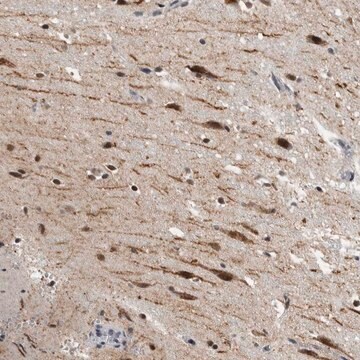MABF3171
Anti-CXCR7 Antibody, clone 10D1
Sinonimo/i:
Atypical chemokine receptor 3, C-X-C chemokine receptor type 7, CXC-R7, CXCR-7, Chemokine orphan receptor 1, G-protein coupled receptor 159, G-protein coupled receptor RDC1 homolog, RDC-1
About This Item
Prodotti consigliati
Origine biologica
mouse
Livello qualitativo
Forma dell’anticorpo
purified antibody
Tipo di anticorpo
primary antibodies
Clone
10D1, monoclonal
Reattività contro le specie
human
Confezionamento
antibody small pack of 100
tecniche
flow cytometry: suitable
inhibition assay: suitable
Isotipo
IgG2a
Sequenza dell’epitopo
Extracellular domain
N° accesso ID proteina
N° accesso UniProt
Informazioni sul gene
human ... ACKR3(57007)
Specificità
Immunogeno
Applicazioni
Evaluated by Flow Cytometry in Raji cells.
Flow Cytometry Analysis: 1 µg of this antibody detected CXCR7 in one million Raji cells.
Tested Applications
Inhibition Assay: A representative lot inhibited the binding to the principal ligand CXCL12 to CXCR7. (Patent ID: WO2010141986A1).
Flow Cytometry Analysis: A representative lot detected CXCR7 in Flow Cytometry applications (Patent ID: WO2010141986A1).
Note: Actual optimal working dilutions must be determined by end user as specimens, and experimental conditions may vary with the end user
Descrizione del bersaglio
Stato fisico
Ricostituzione
Stoccaggio e stabilità
Altre note
Esclusione di responsabilità
Non trovi il prodotto giusto?
Prova il nostro Motore di ricerca dei prodotti.
Codice della classe di stoccaggio
12 - Non Combustible Liquids
Classe di pericolosità dell'acqua (WGK)
WGK 2
Punto d’infiammabilità (°F)
Not applicable
Punto d’infiammabilità (°C)
Not applicable
Certificati d'analisi (COA)
Cerca il Certificati d'analisi (COA) digitando il numero di lotto/batch corrispondente. I numeri di lotto o di batch sono stampati sull'etichetta dei prodotti dopo la parola ‘Lotto’ o ‘Batch’.
Possiedi già questo prodotto?
I documenti relativi ai prodotti acquistati recentemente sono disponibili nell’Archivio dei documenti.
Il team dei nostri ricercatori vanta grande esperienza in tutte le aree della ricerca quali Life Science, scienza dei materiali, sintesi chimica, cromatografia, discipline analitiche, ecc..
Contatta l'Assistenza Tecnica.








